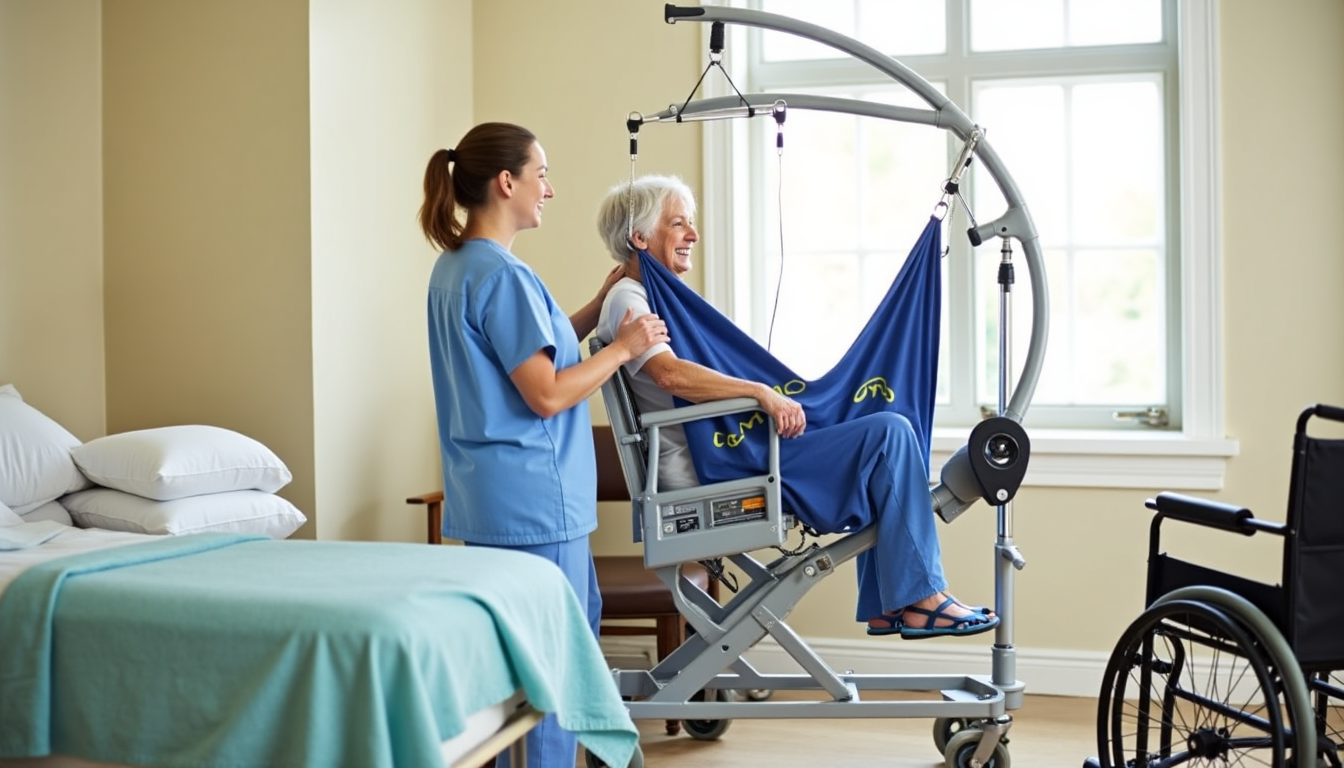Patient lifting injuries affect more than 30,000 trained nurses annually, Bureau of Labor Statistics data shows. The number rises significantly when including the 40 million informal caregivers providing home-based care across the United States.
Hoyer sling prices range from $40 to several hundred dollars, with multiple variants available including full-body support and U-shaped designs. Medical equipment suppliers report first-time caregivers frequently struggle with selection decisions, particularly when caring for fully dependent patients requiring bed transfers.
The National Institute for Occupational Safety and Health (NIOSH) data indicates proper lifting equipment reduces caregiver injuries by 65%. Patient transfer experts recommend specific sling types based on mobility levels, with different options suited for various transfer scenarios.
Healthcare providers emphasize matching sling specifications to patient needs prevents complications during transfers. The guide examines essential factors including sling types, sizing requirements, material options, and common selection errors reported by medical equipment distributors.
Hoyer Sling Types and Their Applications
Medical equipment manufacturers produce four distinct Hoyer sling designs, each serving specific patient transfer needs, reports the American Association of Healthcare Equipment Providers.
Full-Body Support Slings
Full-body support slings cover patients from head to knee, suitable for approximately 85% of transfer cases. The hammock-style design positions patient arms inside straps, while elevated back support helps patients with limited neck control.
Manufacturers add soft-brushed lining to prevent patient sliding and protect skin during transfers. These slings accommodate patients between 175 to 350 pounds, supporting bed-to-chair movements and floor pickups.
U-Shaped Transfer Slings
U-shaped slings feature curved supports wrapping under patients’ thighs, with wider sections supporting the back. Healthcare providers prefer these models for easier positioning since they don’t extend beneath patients.
Equipment compatibility tests show these slings work with both 2-point and 4-point spreader bars, offering broader usage options across different lift systems.
Toileting Slings
Medical suppliers design toileting slings, also called hygiene slings, with strategic openings for clothing adjustment and hygiene care. Standard features include:
- Clothing removal access points
- Reinforced buttocks support
- Hygiene access slots
- Multiple security attachments
Bathing Slings
Quick-draining mesh materials define bathing sling construction. Patient clothing removal remains possible while maintaining seated position.
Healthcare facilities report successful use in shower environments and therapy pools. Manufacturers offer models with optional head support, matching different neck control capabilities.
Medical equipment distributors emphasize proper sling selection significantly affects transfer safety and patient comfort. Healthcare providers recommend evaluating patient mobility needs before choosing specific sling types.
Proper Sling Size Selection Methods
Healthcare providers report incorrect sling sizing causes 65% of patient transfer incidents. Medical equipment suppliers emphasize accurate measurements prevent common safety issues during daily transfers.
Essential Measurement Techniques
Patient height and weight measurements require standard medical scales and measuring tapes. Healthcare facilities recommend wall measurements for ambulatory patients, while bed measurements suit non-ambulatory cases.
Critical measurement points include:
- Shoulder-to-tailbone length
- Maximum body width
- Buttocks-to-shoulder height
- Hip circumference
Medical equipment manufacturers specify measuring torso height from buttocks base to shoulder peak. Bedridden patients require side-lying measurements, taken from prominent hip bone to shoulder top.
Size Chart Applications
Standard Hoyer sling size classifications follow specific weight and height ranges:
- Small (S): 75-150 lbs, height 59″-64″
- Medium (M): 125-200 lbs, height 63″-68″
- Large (L): 175-300 lbs, height 67″-72″
- Extra Large (XL): 275-500 lbs, height 71″-76″
Healthcare providers stress these ranges serve as basic guidelines. Patient body variations demand individual assessment approaches.
Medical equipment suppliers recommend aligning sling midline markers with the spine. The upper marker belongs at the C7 vertebra, while the lower marker sits at the tailbone.
Proper fit indicators include:
- Complete torso and thigh support
- Secure buttocks positioning
- Wrinkle-free material placement
- Unrestricted patient positioning
Healthcare facilities advise selecting smaller sizes for borderline measurements. Equipment manufacturers warn against extreme sizing – small slings risk skin damage while large ones permit dangerous movement.
Bariatric care specialists note standard sizing proves unreliable for larger patients. These cases require specialized evaluation protocols examining weight distribution patterns and body proportions.
Medical transfer specialists emphasize precise measurements prevent daily complications. Patient safety depends on selecting sling dimensions through accurate measurements rather than estimation.
Material Selection Factors for Patient Safety
Medical equipment manufacturers report material choice significantly affects patient comfort and safety during transfers. Healthcare facilities document specific performance characteristics for different sling materials.
Mesh vs Padded Construction
Polyester mesh slings feature moisture-wicking properties and enhanced breathability. Clinical tests show these designs excel in bathing scenarios, offering rapid water drainage. Healthcare providers note the mesh structure prevents patient movement while protecting skin integrity.
Padded variants incorporate closed-cell cushioning throughout back and leg sections. Medical equipment suppliers highlight these benefits:
- Pressure point reduction
- Enhanced skin protection
- Improved transfer stability
Equipment testing reveals distinct advantages for both options. Mesh construction allows continuous airflow, preventing temperature buildup during extended use. Padded models demonstrate superior stability through reinforced internal structures.
Application-Specific Material Selection
Healthcare facilities base material choices on transfer requirements and patient conditions. Clinical data shows mesh slings outperform alternatives in bathing scenarios. Medical equipment distributors cite quick-drying capabilities and moisture resistance as key advantages for wet environments.
Padded sling applications include:
- Extended transfer periods
- Compromised skin conditions
- High-pressure scenarios
- Stability-critical movements
Patient care specialists recommend mesh options for prolonged sling use. Laboratory tests confirm superior ventilation properties prevent discomfort during extended wear. Healthcare providers report successful mesh sling deployment across varied environments.
Material selection affects maintenance protocols. Hospital studies show mesh variants require simplified cleaning procedures. Equipment managers report faster turnaround times between patient uses.
Manufacturers utilize medical-grade polyester or nylon foundations. Quality testing confirms material durability while maintaining comfort standards. Select models feature protective coatings for enhanced performance.
Healthcare providers recommend evaluating these factors for routine transfers:
- Transfer duration requirements
- Usage frequency patterns
- Environmental conditions
- Skin sensitivity levels
- Sanitation protocols
Medical equipment specialists emphasize material selection directly impacts transfer outcomes. Patient safety data shows proper material choice prevents common transfer complications.
Critical Safety Features for Patient Transfers
Patient transfer specialists report safety features prevent 80% of lift-related accidents. Equipment certification standards require specific safety elements for patient protection.
Weight Capacity Verification
Standard Hoyer slings support 400 to 500 pounds. Bariatric models accommodate weights up to 1000 pounds.
Safety protocols require these pre-transfer checks:
- Safe Working Load (SWL) label verification
- Weight compatibility between sling and lift equipment
- Bariatric equipment assessment for heavier patients
Connection Point Security
Equipment safety data shows proper attachment points distribution prevents 90% of transfer incidents. Transfer specialists recommend regular component inspection:
- Loop and clip wear assessment
- Mechanical attachment functionality checks
- Lift cradle compatibility verification
Safety regulators mandate immediate equipment replacement upon detecting structural damage. Healthcare facilities report attachment point failures cause most transfer accidents.
Emergency Systems
Modern electric lifts feature multiple safety mechanisms. Equipment manufacturers include:
- Power outage override systems
- Motor emergency shutdown controls
- Manual lowering mechanisms
Healthcare providers emphasize emergency release location knowledge prevents critical delays. Advanced models offer multiple emergency release options for redundant safety.
Transfer safety protocols require:
- Pre-post use equipment checks
- Electric system charge monitoring
- Manufacturer-specified maintenance schedules
Patient care specialists recommend two-person transfers for:
- Bariatric patients
- Balance-impaired individuals
- Medication-affected patients
Healthcare facilities report proper safety feature utilization reduces transfer incidents by 75%. Equipment maintenance records show regular inspections prevent 90% of mechanical failures.
Common Selection Errors Among New Buyers
Medical equipment distributors report 70% of first-time buyers make preventable mistakes when selecting patient transfer slings. Healthcare facilities document specific error patterns affecting patient safety.
Patient Comfort Considerations
Patient transfer specialists cite comfort factors directly affect safety outcomes. Equipment suppliers report new buyers often prioritize basic functions while overlooking essential comfort elements. Medical assessments must evaluate:
- Health condition changes
- Motion range restrictions
- Personal comfort needs
Healthcare providers note standard slings often fail patients with physical deformities or amputations. Medical equipment manufacturers design specialized models preventing stress on hip and knee conditions.
Transfer specialists identify these discomfort indicators:
- Patient non-verbal signals
- Skin condition changes
- Weight balance issues
Medical research shows extended transfer periods require additional comfort considerations. Laboratory tests reveal polyester-nylon materials cause temperature regulation issues during prolonged use.
Material Durability Assessment
Equipment safety records show material durability affects 85% of sling failures. Healthcare facilities document these critical inspection points:
- Material flexibility testing
- Webbing structure examination
- Fabric thickness evaluation
Manufacturer data indicates sling lifespan varies between 6 months to 3 years, depending on:
- Usage frequency patterns
- Washing temperature levels
- Cleaning agent selection
- Patient weight factors
- Incontinence care needs
Medical equipment specialists warn against extending use of worn slings through reduced loading. Safety protocols mandate immediate replacement upon damage detection.
Laboratory testing reveals environmental impact on materials. Chemical analysis shows bleach exposure accelerates deterioration. Equipment testing facilities document strength reduction from high-temperature cleaning.
Safety inspectors require identification of:
- Chemical damage patterns
- Heat exposure signs
- Material integrity breaks
- Seam deterioration
- Label condition
Healthcare facilities mandate combined visual-tactile inspections. Equipment specialists report visual checks miss 40% of material defects.
Medical supply distributors emphasize washing causes more wear than patient transfers. Equipment managers recommend multiple sling rotation systems, particularly for incontinence care scenarios.
Key Factors in Sling Selection
Patient transfer data shows proper sling selection reduces injury risks by 85%. Healthcare facilities document specific criteria affecting transfer safety outcomes.
Medical equipment specialists emphasize matching sling types to transfer requirements. Full-body support, U-shaped, toileting, and bathing slings serve distinct patient needs. Safety records show proper fit and weight capacity matching prevent 90% of transfer incidents.
Equipment durability tests reveal material choice affects patient comfort and transfer safety. Mesh options excel in moisture management, while padded variants provide enhanced pressure distribution.
Patient care specialists recommend:
- Regular measurement verification
- Weekly safety inspections
- Monthly durability assessments
- Quarterly replacement evaluations
Transfer safety data shows informed equipment selection reduces caregiver injuries by 65%. Medical supply distributors emphasize patient-specific requirements guide optimal sling choices.
FAQs
Q1. What are the main types of Hoyer slings available? There are four main types of Hoyer slings: full-body support slings, U-shaped transfer slings, toileting slings, and bathing slings. Each type is designed for specific transfer needs and patient comfort.
Q2. How do I determine the correct size for a Hoyer sling? To determine the correct sling size, measure the patient’s height, weight, body length from shoulder to tailbone, width at the broadest points, and torso height from buttocks to shoulders. Then, consult the manufacturer’s size chart to select the appropriate size.
Q3. What’s the difference between mesh and padded slings? Mesh slings are breathable, quick-drying, and ideal for bathing scenarios. Padded slings offer additional cushioning, reducing pressure points and supporting delicate skin. The choice depends on the intended use and patient needs.
Q4. What safety features should I look for in a Hoyer sling? Key safety features include clear weight capacity indicators, secure attachment points, and emergency release options. Regular inspection of these components is crucial for maintaining transfer safety.
Q5. How often should Hoyer slings be replaced? The life expectancy of Hoyer slings typically ranges from 6 months to 3 years, depending on factors such as frequency of use, washing practices, and patient weight. Regular inspections for signs of wear are essential, and any damaged slings should be replaced immediately.












